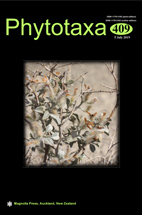Abstract
A new species of Amanita subgenus Amanita sect. Vaginatae is described and illustrated based on material collected in pine forests in district Mansehra, Khyber Pakhtoonkhaw, Pakistan. Amanita mansehraensis is recognized by the presence of a light brown or light greyish olive pileus with strong brown or deep brown pileus center; non-appendiculate, rimose, sulcate or plicate striate pileus margin; subglobose to ellipsoid basidiospores; and a saccate volva. The internal transcribed spacer region (ITS) and large subunit of the nuclear ribosomal RNA gene (nrLSU) were used for the delimitation of this species based on sequence data. The evolutionary relationships of A. mansehraensis with other species of Amanita were inferred by means of Maximum Likelihood and Bayesian inferences of the nrLSU dataset and concatenated ITS+nrLSU dataset. Amanita mansehraensis is most closely related to A. brunneofuliginea, A. pseudovaginata, and the recently described A. glarea.

